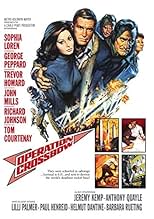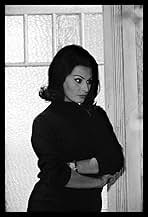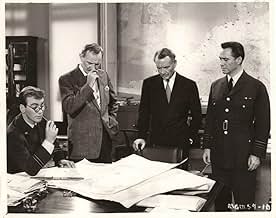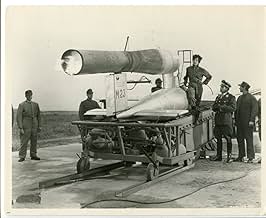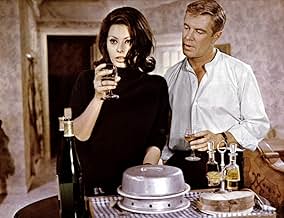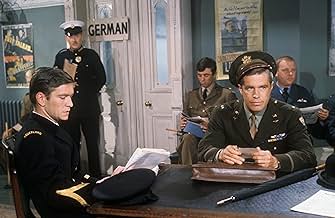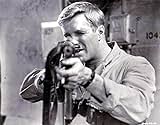NOTE IMDb
6,6/10
5,8 k
MA NOTE
Des agents alliés tentent d'infiltrer un site de recherche spatiale nazi.Des agents alliés tentent d'infiltrer un site de recherche spatiale nazi.Des agents alliés tentent d'infiltrer un site de recherche spatiale nazi.
- Réalisation
- Scénario
- Casting principal
- Récompenses
- 1 victoire au total
Barbara Rütting
- Hannah Reitsch
- (as Barbara Rueting)
Avis à la une
"Operation Crossbow" is a fictional movie based on historical events of World War II. It's a historical look at Hitler's program to develop rocket weapons and the Allied efforts to foil the Germans. The plot has enough intrigue and action to make the film entertaining. And, the bombing scenes keep the sense of urgency about the race between the Allies and the Germans the last two years that would determine the war's outcome.
The film has a cast of notable movie stars of the day; but I think only a couple stand out for their performances. Trevor Howard is excellent as Professor Lindemann, and Tom Courtenay is very good and convincing as Robert Henshaw.
The real pluses for this film are four. First, it's a reasonable portrayal of historical events and some key people of the time. Second, it has excellent camera work. Third, it has very good recreations of the German rockets and testing sites and of the bombing scenes in London and the air raids on the German sites. Fourth, it uses some actual war film footage sparingly.
During World War II, Operation Crossbow was the code name for the overall Allied effort to destroy the German rocket and long-range bombing projects. It began in early 1943, under the code name "Bodyline," when Allied planes photographed a V-2 rocket site in northern France. The code name changed that fall.
Some of the film characters are based on real people and use their names. Others are amalgams of people. The roles of the main stars aren't real people. Besides Winston Churchill, other British leaders portrayed were real. Richard Johnson plays Duncan Sandys who was in charge of Operation Crossbow. He had been wounded while fighting with British forces in Norway after Germany invaded that country in early 1940. He also was Churchill's son-in-law at the time.
In this movie, Sandys often is at odds with the chief science adviser to his group, Professor Lindemann. Frederick Lindemann was a real person and the chief science adviser to the British war effort. He was a close friend of Winston Churchill and made significant contributions to the Allied war efforts. But, he believed that the German rocket program was a hoax. Another leading scientific adviser was Reginald V. Jones with whom Sandys often clashed. It seems that the film writers combined the two British scientists under the character of Lindemann.
Constance Babington Smith, played by Sylvia Syms, was another very real person in the film. She was the British photo interpreter who first spotted a German rocket site from aerial photos. Another real character was Hanna Reitsch, played by Barbara Rutting. Reitsch was a renowned German aviatrix who set many flying records. She was a test pilot for the Nazis and was the only woman to receive the Iron Cross first class. She survived the war and set many glider records. Reitsch died at age 67 in August, 1979, at Frankfurt – then, West Germany.
MGM's British film group did an excellent job recreating the German Peenemünde rocket research and testing site. The filming was done along the Norfolk coast, NNE of London. Its North Sea location and coastline probably very closely resembled the real German site along the Baltic Sea.
Watching this film again, I understood how the British early on were concerned about Germany's advances in weapons. After the war, and through the 1950s, there was a general sense in the U.S. – and perhaps much of the world – that the Germans were generally superior in the fields of science and engineering. I grew up with that notion. My dad had served in the Army in Europe during WW II, and I later served in the Army in Germany during the Cold War. The Germans continued to excel in cameras, tape recorders, other electronic production and automobiles. But, with the passage of time and greater public awareness of recent history, we now know more about the seeming German prowess in the sciences.
In fact, most of technology and development of the German rocket program had been pioneered almost two decades before by an American scientist, Robert H. Goddard (1882-1945). Today, Goddard is recognized as the father of modern rocketry and the father of the space age. How ironic that when he died in 1945, many still doubted and dismissed him and his work. Yet, he had launched the world's first liquid-fueled rocket in March 1926; and he and his team had launched 34 rockets from then until 1941. He was working with grant monies and obtained more than 200 patents. But much of his work took place during the depression. And, no one – the U.S. government included, seemed interested in all the possibilities that Goddard had envisioned from rocket science and achievements.
My DVD of "Operation Crossbow" had a 10-minute short special with it, "A Look Back at Crossbow." It has some early film clips of Goddard's first attempts to launch rockets. One can see these today on YouTube. This short documentary noted that Germany collected all of the Goddard research achievements for a mere 10 cents per copy from the U.S. Patent Office. And, Adolf Hitler had his Nazi regime embark on a huge R&D program for weapons superiority shortly after he came to power in 1932. The rest is history.
Another American also had much to do with Japan's recovery after the war. W. Edwards Deming was a scientist whose work Japanese industry took seriously. In just two decades, Japan grew to become a world power based on its high quality and innovative production. Japan's industry created the Deming Prize in 1951. President Reagan awarded Deming the National Medal of Technology in 1987. But, just as with Robert Goddard, Deming's work wasn't widely recognized in the U.S. until after his death in 1993. And, that's another whole story.
The film has a cast of notable movie stars of the day; but I think only a couple stand out for their performances. Trevor Howard is excellent as Professor Lindemann, and Tom Courtenay is very good and convincing as Robert Henshaw.
The real pluses for this film are four. First, it's a reasonable portrayal of historical events and some key people of the time. Second, it has excellent camera work. Third, it has very good recreations of the German rockets and testing sites and of the bombing scenes in London and the air raids on the German sites. Fourth, it uses some actual war film footage sparingly.
During World War II, Operation Crossbow was the code name for the overall Allied effort to destroy the German rocket and long-range bombing projects. It began in early 1943, under the code name "Bodyline," when Allied planes photographed a V-2 rocket site in northern France. The code name changed that fall.
Some of the film characters are based on real people and use their names. Others are amalgams of people. The roles of the main stars aren't real people. Besides Winston Churchill, other British leaders portrayed were real. Richard Johnson plays Duncan Sandys who was in charge of Operation Crossbow. He had been wounded while fighting with British forces in Norway after Germany invaded that country in early 1940. He also was Churchill's son-in-law at the time.
In this movie, Sandys often is at odds with the chief science adviser to his group, Professor Lindemann. Frederick Lindemann was a real person and the chief science adviser to the British war effort. He was a close friend of Winston Churchill and made significant contributions to the Allied war efforts. But, he believed that the German rocket program was a hoax. Another leading scientific adviser was Reginald V. Jones with whom Sandys often clashed. It seems that the film writers combined the two British scientists under the character of Lindemann.
Constance Babington Smith, played by Sylvia Syms, was another very real person in the film. She was the British photo interpreter who first spotted a German rocket site from aerial photos. Another real character was Hanna Reitsch, played by Barbara Rutting. Reitsch was a renowned German aviatrix who set many flying records. She was a test pilot for the Nazis and was the only woman to receive the Iron Cross first class. She survived the war and set many glider records. Reitsch died at age 67 in August, 1979, at Frankfurt – then, West Germany.
MGM's British film group did an excellent job recreating the German Peenemünde rocket research and testing site. The filming was done along the Norfolk coast, NNE of London. Its North Sea location and coastline probably very closely resembled the real German site along the Baltic Sea.
Watching this film again, I understood how the British early on were concerned about Germany's advances in weapons. After the war, and through the 1950s, there was a general sense in the U.S. – and perhaps much of the world – that the Germans were generally superior in the fields of science and engineering. I grew up with that notion. My dad had served in the Army in Europe during WW II, and I later served in the Army in Germany during the Cold War. The Germans continued to excel in cameras, tape recorders, other electronic production and automobiles. But, with the passage of time and greater public awareness of recent history, we now know more about the seeming German prowess in the sciences.
In fact, most of technology and development of the German rocket program had been pioneered almost two decades before by an American scientist, Robert H. Goddard (1882-1945). Today, Goddard is recognized as the father of modern rocketry and the father of the space age. How ironic that when he died in 1945, many still doubted and dismissed him and his work. Yet, he had launched the world's first liquid-fueled rocket in March 1926; and he and his team had launched 34 rockets from then until 1941. He was working with grant monies and obtained more than 200 patents. But much of his work took place during the depression. And, no one – the U.S. government included, seemed interested in all the possibilities that Goddard had envisioned from rocket science and achievements.
My DVD of "Operation Crossbow" had a 10-minute short special with it, "A Look Back at Crossbow." It has some early film clips of Goddard's first attempts to launch rockets. One can see these today on YouTube. This short documentary noted that Germany collected all of the Goddard research achievements for a mere 10 cents per copy from the U.S. Patent Office. And, Adolf Hitler had his Nazi regime embark on a huge R&D program for weapons superiority shortly after he came to power in 1932. The rest is history.
Another American also had much to do with Japan's recovery after the war. W. Edwards Deming was a scientist whose work Japanese industry took seriously. In just two decades, Japan grew to become a world power based on its high quality and innovative production. Japan's industry created the Deming Prize in 1951. President Reagan awarded Deming the National Medal of Technology in 1987. But, just as with Robert Goddard, Deming's work wasn't widely recognized in the U.S. until after his death in 1993. And, that's another whole story.
Exciting WWII military thriller including a moving final and overwhelming pyrotechnics . This interesting picture packs big stars , intrigue , action packed , suspense and historic deeds . It deals with a trio (George Peppard , Tom Courtneay, Jeremy Kemp) of Allied agents are assigned by high command (John Mills , Richard Johnson , Trevor Howard , Richard Todd , Maurice Denham) to destroy a Nazi munitions installation . They attempt to infiltrate the Nazis' rocket research site. Their mission is complicated by appearing a wife (Sophia Loren) , one traitor and several dangers .
Thrilling war film in which there are nail-biting action scenes , drama , intrigue , explosion , suspenseful set pieces and almost overloaded with stars . The movie gets a simple emotional appeal , professionalism and being rightly shot . This film's title is the same code-name for the real World War II spy mission, which was code-named "Crossbow". After the Second World War, because of this movie's title, reference to these events popularized them as being "Operation Crossbow" . This blazing WWII yarn pulled the public into cinemas in droves when it was first released . Director Michael Anderson steered skillfully through its numerous twists . Despite receiving top billing , Sophia Loren only appears in a extended cameo role ; producer Carlo Ponti, Loren's husband, believed his wife's popularity in the United States would boost the film's chances at the box office and had her billed accordingly . Filmed on splashy color and brilliant cinematography by cameraman Erwin Hillier . Breathtaking as well as evocative musical score by Ron Goodwin . Excellent production design and nice special effects , for the section of the film where RAF Bomber Command raid the Peenemunde rocket research site the producers used the Avro Lancaster PA474 used by the Cranfield institute of technology . For the scene in which a street is wiped out by a V-2, the filmmakers actually destroyed a row of flats which were slated for demolition , the shot was, necessarily, done in one take.
This movie is based on historical events , as there appears the character of Hannah Reitsch, played by Barbara Rütting , was a real-life person . Reitsch was a German aviatrix and at one time Adolf Hitler's own personal pilot. During the Battle of Berlin, Reitsch attempted to persuade Hitler to escape from the city in a small lightweight Fieseler Storch airplane . Furthermore , appears Duncan Sandys, a character in this movie played by Richard Johnson, was a real-life person ; Sandys was Chairman of the British War Cabinet Committee for the Defence against German rockets and flying bombs , he was the son-in-law of British wartime prime minister, Winston Churchill and was wounded during the Second World War in Norway in 1941 which resulted in him having a permanent limp . The motion picture was professionally directed by Michael Anderson . He was a craftsman with reputation for making a variety of commercial and amusing films , it's well demonstrated in ¨Operation Crossbow¨. His films from 1953-58 were all quite well received , his cycle ended with the best of them , the suspense , thriller ,¨Chase a crooked shadow¨ . Latterly resident in Canada , he has continued to direct , mainly in lower-profile projects and TV adventure movies . Anderson has filmed all kind of genres as cinema as TV ; such as Adventure : ¨Around the world in 80 days¨ , ¨Doc Savage¨ , ¨The sea Wolf¨ , ¨20.000 leagues under the sea¨ ; Sci-Fi : ¨Logan's run¨, ¨The martian chronicles¨ , ¨Milennium¨ ; Thriller: ¨The Quiller Memorandum , ¨Dominique is dead¨ , ¨The naked edge¨ , The wreck of the Mary Deare¨ , ¨Murder by phone¨ and Wartime : ¨Battle hell¨, ¨Shake hands with the devil¨, Damm Busters¨ and of course , ¨Operation Crossbow¨ .
Thrilling war film in which there are nail-biting action scenes , drama , intrigue , explosion , suspenseful set pieces and almost overloaded with stars . The movie gets a simple emotional appeal , professionalism and being rightly shot . This film's title is the same code-name for the real World War II spy mission, which was code-named "Crossbow". After the Second World War, because of this movie's title, reference to these events popularized them as being "Operation Crossbow" . This blazing WWII yarn pulled the public into cinemas in droves when it was first released . Director Michael Anderson steered skillfully through its numerous twists . Despite receiving top billing , Sophia Loren only appears in a extended cameo role ; producer Carlo Ponti, Loren's husband, believed his wife's popularity in the United States would boost the film's chances at the box office and had her billed accordingly . Filmed on splashy color and brilliant cinematography by cameraman Erwin Hillier . Breathtaking as well as evocative musical score by Ron Goodwin . Excellent production design and nice special effects , for the section of the film where RAF Bomber Command raid the Peenemunde rocket research site the producers used the Avro Lancaster PA474 used by the Cranfield institute of technology . For the scene in which a street is wiped out by a V-2, the filmmakers actually destroyed a row of flats which were slated for demolition , the shot was, necessarily, done in one take.
This movie is based on historical events , as there appears the character of Hannah Reitsch, played by Barbara Rütting , was a real-life person . Reitsch was a German aviatrix and at one time Adolf Hitler's own personal pilot. During the Battle of Berlin, Reitsch attempted to persuade Hitler to escape from the city in a small lightweight Fieseler Storch airplane . Furthermore , appears Duncan Sandys, a character in this movie played by Richard Johnson, was a real-life person ; Sandys was Chairman of the British War Cabinet Committee for the Defence against German rockets and flying bombs , he was the son-in-law of British wartime prime minister, Winston Churchill and was wounded during the Second World War in Norway in 1941 which resulted in him having a permanent limp . The motion picture was professionally directed by Michael Anderson . He was a craftsman with reputation for making a variety of commercial and amusing films , it's well demonstrated in ¨Operation Crossbow¨. His films from 1953-58 were all quite well received , his cycle ended with the best of them , the suspense , thriller ,¨Chase a crooked shadow¨ . Latterly resident in Canada , he has continued to direct , mainly in lower-profile projects and TV adventure movies . Anderson has filmed all kind of genres as cinema as TV ; such as Adventure : ¨Around the world in 80 days¨ , ¨Doc Savage¨ , ¨The sea Wolf¨ , ¨20.000 leagues under the sea¨ ; Sci-Fi : ¨Logan's run¨, ¨The martian chronicles¨ , ¨Milennium¨ ; Thriller: ¨The Quiller Memorandum , ¨Dominique is dead¨ , ¨The naked edge¨ , The wreck of the Mary Deare¨ , ¨Murder by phone¨ and Wartime : ¨Battle hell¨, ¨Shake hands with the devil¨, Damm Busters¨ and of course , ¨Operation Crossbow¨ .
In the annals of Allied history is one of the most secret and certainly most desperate covert attempts to destroy the Nazi's ultimate weapons. These weapons were called the Vengeance Rockets which nearly destroyed England and it willingness to survive. This story written by Duilio Coleitto and directed by Michael Anderson is comparatively close to the actual facts. The conclusion in England was that the V-1 and V-2 were wreaking havoc on London and the prime Minister (Patrick Wymark) called on his war ministry to design a plan to destroy them. Innically, the secret operation was called 'Operation Bodyline' but changed for the movie under " Operation Crossbow." The idea was to select allied officers, trained and educated as engineers, fly them to Germany, have them infiltrate the German War Machine and sabotage the entire V-rocket plant. What they did not harp on was that is was also considered a suicide mission. George Peppard, Tom Courtenay and Jeremy Kemp play the incredibly courageous allied agents who must carry out the task. Anthony Quayle is superb as the traitorous English/German counter agent who's job it is to stop them. Richard Todd, Paul Henreid, Trevor Howard, John Mills, Richard Johnson and Sophia Loren round out the cast. The movie is incredible with actual WWII footage and surprisingly great dramatic acting. The introduction of Sophia Loren within the actual story is puzzling, but interesting. A very good WWII action movie considered a Classic by many movie fans. ****
In some ways an old-fashioned, star-studded, overstuffed "mission" movie, "Operation Crossbow" has, to me, an authentic WWII feeling to it. I'm guessing this movie's scenes and attitudes may have resonated with people in 1965 who'd lived through that period.
World War II was Big, and that's reflected here. The movie's individual characters are less important than the group war effort, something they're very aware of. And the nothing-personal killing of one character by a Resistance member, is pretty stunning. My hat is off to that.
Side note: During the '60s did Thomas Pynchon ("Gravity's Rainbow") go see this movie? He was then working on his big novel about the V-2 rocket. People have noodled about a possible cause-and-effect between movie and novel, including Dave Kehr in the NYTimes. FWIW, somewhere in "Gravity" I think there's a description of someone's wristwatch being worn on the inside of the wrist, "World War II style." (So the luminous hands wouldn't show during night operations??) That's the way George Peppard wears his watch.
World War II was Big, and that's reflected here. The movie's individual characters are less important than the group war effort, something they're very aware of. And the nothing-personal killing of one character by a Resistance member, is pretty stunning. My hat is off to that.
Side note: During the '60s did Thomas Pynchon ("Gravity's Rainbow") go see this movie? He was then working on his big novel about the V-2 rocket. People have noodled about a possible cause-and-effect between movie and novel, including Dave Kehr in the NYTimes. FWIW, somewhere in "Gravity" I think there's a description of someone's wristwatch being worn on the inside of the wrist, "World War II style." (So the luminous hands wouldn't show during night operations??) That's the way George Peppard wears his watch.
"Operation Crossbow" was quite a hit in its day but is not seen as being in the same league as films such as "The Guns of Navarone" or "The Great Escape". Nevertheless, it is a very worthy film on many levels.
Firstly, the cast is uniformly excellent with supporting roles taken by some of Britain's acting luminaries such as Trevor Howard, John Mills and Richard Todd. The leading man is George Peppard who plays the role with his characteristically understated charm and, when called upon, a very believable physicality. Some have been critical of the fact that Sophia Loren is billed as a co-star and has very limited screen time. However, her performance as an innocent caught up in a desperate and finally unfairly cruel situation is worth watching. So too is the performance of her killer played by Lilli Palmer who embodies the emotional control, deceptiveness, resourcefulness and cool ruthlessness required by resistance contacts whose every move was potentially their last. Bouquets to Barbara Rutting who plays the real life character of Hannah Reitsch with a steely resolve and belief that had me looking up the life story of the Nazi test pilot. She remained a dedicated National Socialist until her death and was highly critical of post-war Germany and Germans. She was appalled at the fact that German soldiers by the late 60's were allowed to wear beards and that Germany was in her words now a "nation of bankers and car builders". She won many awards for her feats of aviation after the war. Other historical figures such as Constance Babington Smith, a key figure in identifying V1 rocket sites, and Professor Lindemann, who dismissed the Nazi rocket program as being a hoax, are, to my knowledge, faithfully portrayed by Sylvia Syms and Trevor Howard respectively.
The pace of the film is another highlight. The story is told through a number of points of view including the Nazi rocketry program and its own attempts at espionage and counter espionage. Almost every scene has an element of suspense - a mini story within the story. There are also some moments of humour seamlessly laced into the drama. Well done to the editor who was faced with the complex task of melding so many story elements into a very cohesive whole.
Lastly, the action scenes and in particular the final destruction of the rocket production plant is comparable to any such "destroy the villain's lair" scene including those in the Bond series. The stunts and special effects stand up very well after almost 50 years.
Firstly, the cast is uniformly excellent with supporting roles taken by some of Britain's acting luminaries such as Trevor Howard, John Mills and Richard Todd. The leading man is George Peppard who plays the role with his characteristically understated charm and, when called upon, a very believable physicality. Some have been critical of the fact that Sophia Loren is billed as a co-star and has very limited screen time. However, her performance as an innocent caught up in a desperate and finally unfairly cruel situation is worth watching. So too is the performance of her killer played by Lilli Palmer who embodies the emotional control, deceptiveness, resourcefulness and cool ruthlessness required by resistance contacts whose every move was potentially their last. Bouquets to Barbara Rutting who plays the real life character of Hannah Reitsch with a steely resolve and belief that had me looking up the life story of the Nazi test pilot. She remained a dedicated National Socialist until her death and was highly critical of post-war Germany and Germans. She was appalled at the fact that German soldiers by the late 60's were allowed to wear beards and that Germany was in her words now a "nation of bankers and car builders". She won many awards for her feats of aviation after the war. Other historical figures such as Constance Babington Smith, a key figure in identifying V1 rocket sites, and Professor Lindemann, who dismissed the Nazi rocket program as being a hoax, are, to my knowledge, faithfully portrayed by Sylvia Syms and Trevor Howard respectively.
The pace of the film is another highlight. The story is told through a number of points of view including the Nazi rocketry program and its own attempts at espionage and counter espionage. Almost every scene has an element of suspense - a mini story within the story. There are also some moments of humour seamlessly laced into the drama. Well done to the editor who was faced with the complex task of melding so many story elements into a very cohesive whole.
Lastly, the action scenes and in particular the final destruction of the rocket production plant is comparable to any such "destroy the villain's lair" scene including those in the Bond series. The stunts and special effects stand up very well after almost 50 years.
Le saviez-vous
- AnecdotesFor the scene in which a street is wiped out by a V2, the filmmakers destroyed a row of flats which were slated for demolition.
- GaffesAlthough piloted V-1s were built, they were launched from aircraft, not ramps. None were ever used in combat. Hanna Reitsch flew one to establish why other pilots crashed them on landing. She found that the problem was caused by the aircraft's exceptionally high stall speed.
- Citations
Phil Bradley: The first rocket I built rose three feet into the ground. The second took off horizontally, went straight through a hen-house and killed 40 roosters.
Bradley's Interviewer: How very discouraging for you. What did you do after that?
Phil Bradley: Buried the roosters, sir.
- ConnexionsEdited into Opération V2 (1969)
Meilleurs choix
Connectez-vous pour évaluer et suivre la liste de favoris afin de recevoir des recommandations personnalisées
- How long is Operation Crossbow?Alimenté par Alexa
Détails
- Date de sortie
- Pays d’origine
- Langues
- Aussi connu sous le nom de
- Code Name: Operation Crossbow
- Lieux de tournage
- RAF Abingdon Parachute School, Abingdon, Oxfordshire, Angleterre, Royaume-Uni(Parachute training scenes)
- Société de production
- Voir plus de crédits d'entreprise sur IMDbPro
- Durée1 heure 55 minutes
- Rapport de forme
- 2.35 : 1
Contribuer à cette page
Suggérer une modification ou ajouter du contenu manquant

Lacune principale
By what name was Opération Crossbow (1965) officially released in India in English?
Répondre
